Презентація на тему:
ME Scand Norman Conquest, London dialect, Literature
Завантажити презентацію
ME Scand Norman Conquest, London dialect, Literature
Завантажити презентаціюПрезентація по слайдам:
MIDDLE ENGLISH PERIOD In early Middle English the differences between the regional dialects increased. Dialectal differences in early Middle English were accentuated by such historical events as the Scandinavian invasion and the Norman Conquest.
The Scandinavian Invasion The Scandinavian Invasion embraces over two centuries. The British Isles were ravaged first by Danes and later by Norwegians in the 8-th century. By the end of the 9-th century the Danes obtained permanent settlement in England.
Danelaw More than half of England was recognized as Danish territory – “Danelaw”. In the early years of the occupation the Danish settlements were armed camps. Later the Danes began to bring their families.
The new settlers and English intermarried and intermixed. They lived close together and they intermingled easily as there was no linguistic barrier between them.
OE and Old Scandinavian belonged to the Germanic group of languages and at that time were close. The intermixture of the newcomers and English continued from the 9-th century on, during two hundred years.
Scandinavian Place-Names In the areas of the heaviest settlement the Scandinavians outnumbered the Anglo-Saxon population. In Yorkshire, Lincolnshire, Northumberland, Cumberland up to 75% of the place-names are Danish and Norwegian.
-thorp More than 1400 English villages and towns bear names of Scandinavian origin with the element -thorp “village”: Althorp, Woolthorp, Linthorp
thwaite Many place-names contain the word thwaite (an isolated piece of land): Applethwaite, Braithwaite, Cowperthwaite.
Eventually the Scandinavians were absorbed into the local population both ethnically and linguistically.
Due to the contacts and mixture of Old Scandinavian with chiefly Northumbrian and East Mercian, these dialects acquired Scandinavian features.
Native or Borrowed It is difficult to decide whether a word in Modern E is a native or a borrowed one because of the similarity between Old E and the language of the Scandinavian invaders.
Many of the common words of the two languages were identical. But in some case there are very reliable criteria by which we can recognize a borrowed word.
reliable criteria differences in the development of certain sounds in the North Germanic and West Germanic areas.
The development of the sound sk in OE it was early palatalized to / / (written as sc), except in the combination scr in the Scandinavian countries it retained its hard sk sound
native words like ship, shall, fish have sh in Modern E words borrowed from the Scandinavian are generally still pronounced with sk: sky, skin, skill, scrape, scrub, bask
The retention of hard k and g in such words as kid, dike, get, give, gild, egg is an indication of Scandinavian origin.
There existed in Middle E the form geit, gait which are from Scandinavian, beside gāt, gōt from the OE word. The native word has survived in Modern E goat.
But modern word bloom could come equally well from OE blōma or Scandinavian blōm. But the OE word meant an “ingot of iron”, whereas the Scandinavian word meant “flower, bloom”.
It happens that the OE word has survived as a term in metallurgy, but it is the Old Norse word that has come down in ordinary use.
The Norman Conquest The Norman Conquest had a greater effect on the English language than any other in the course of history. The Norman Conquest began in 1066.
The Normans By origin the Normans were a Scandinavian tribe that two centuries back began their inroads on the northern part of France and they finally occupied the territory on the both banks of the Seine.
The territory occupied by the Normans was called Normandy. Normandy is the district extending 75 miles back from the Channel across from England on the northern coast of France.
The Normans adopted the French language and culture. When the Normans came to Britain they brought the French language with them.
In 1066 when Edward the Confessor died after a reign of 24 years Harold Godwin was proclaimed king of England. As soon as the news reached William of Normandy he landed in Britain.
The battle of Hastings In the battle of Hastings (October 1066) Harold was killed and the English were defeated. This date is the date of the Norman Conquest.
After the victory at Hastings William was crowned king. William and his barons laid waste many lands and burned down many towns and villages.
Northumbria and Mercia were almost depopulated. Most of the lands of the Anglo-Saxon lords passed into the hands of the Normans barons.
The most immediate consequence of the Norman domination in Britain is the wide use of the French language in many spheres of life.
For almost 3 hundred years French was the official language of administration the king’s court the law courts the church the army
It was the everyday language of : many nobles the higher clergy many townspeople in the South
The intellectual life, literature, education were run by French-speaking people. French and Latin were the languages of writing. For teaching French was used too and translations from Latin were done into French.
It is true that English was an uncultivated tongue, the language of a socially inferior class.
But the greater part of the population used their native tongue: lower classes in the towns, people in the country-side. In Midlands and up north people continued to speak English and French was foreign to them.
That English survived for a considerable time in some monasteries is evident from the fact that at Peterborough the Anglo-Saxon Chronicle was continued until 1154.
But most of the people were illiterate and the English language was used exclusively as a spoken one.
But slowly the two languages began to permeate each other. Probably many people became bilingual and had a fair command of both languages.
According to some sources William the Conqueror made an effort himself at the age of 43 to learn English, that he might understand and render justice in the disputes.
But these linguistic conditions were gradually changing as English was the living language of the whole population but French was restricted to some social spheres and to writing.
The earliest recognition of English by the Norman kings was “Proclamation” issued by Henry III in 1258. It was written in three languages: French, Latin and English.
In 1362 the English language became the language of the Parliament, courts of law and at the end of the century - the language of teaching.
King Henry IV (1399 – 1413) was the first king after the conquest whose native tongue was English. The 300 years of French domination affected English greatly.
Borrowings from French New words, coming from French, were not adopted simultaneously by all English speakers. They were first used in some varieties (in dialects of Southern England). This resulted in growing dialectal differences.
Early Middle English Dialects The regional ME dialects developed from OE dialects. The following dialect groups are distinguished in Early ME:
The Southern group the Kentish dialect (extended its area) the South – Western dialect (a continuation of the OE Saxon dialects but not only West Saxon but also East Saxon.
The East Saxon dialect was not prominent in OE but it became very important in Early ME and it made the basis of the dialect of London in the 12-th and the 13-th centuries
The group of Midland (Central) dialects corresponds to the OE Mercian dialect West Midland East midland
In ME the Midland area became more diversified linguistically than the OE Mercian kingdom. But it occupied approximately the same territory: from the Thames in the South to the Welsh-speaking area in the west and up north to the river Humber.
The Northern dialects developed from OE Northumbrian. In Early ME the Northern dialects included several provincial dialects (Yorkshire, Lancashire) and also what later became known as Scottish.
In Early ME, while the state language and the main language of literature was French, the local dialects were relatively equal.
The London dialect In Late ME, when English had been reestablished as the main language of administration and writing, the London dialect prevailed over the others.
The Rise of the London Dialect The history of London goes back to the Roman period. Even in OE times London was the biggest town in Britain, although the capital of Wessex (the main OE kingdom) was Winchester.
The early ME records made in London (beginning with the Proclamation of 1258) show that the dialect of London was fundamentally East Saxon (the South-Western)
Later records indicate that the speech of London was becoming more mixed and East Midland features prevailed over the Southern features.
Most of the people who came to London after 1/3 of population of Britain died in the epidemics in the middle of the 14-th century were from East Midlands. So Londoners’ speech became close to the East Midland dialect.
The documents produced in London in late 14-th century show obvious East Midland features. The mixed dialect of London extended to two universities: Oxford and Cambridge and it ousted French from official spheres and from writing.
In the 15th century the London dialect had been accepted as a standard, at least in writing in most parts of the country.
ME Literature The literature written in England during the ME period reflects fairly accurately the changing fortunes of English.
During the time that French was the language best understood by the upper classes, the books were in French. All of continental French literature was available for their enjoyment.
The literature in English that has come down to us from the period 1150-1250 is almost exclusively religious or admonitory.
The Ancrene Riwle (statute for nuns), the Ormulum (c.1200), interpretations of Gospel passages are the principal works
“The Owl and the Nightingale” (c. 1195) is a long poem in which two birds exchange recriminations in the liveliest fashion. The hundred years from 1150 to 1250 have been justly called the Period of Religious Record.
The separation of the English nobility from France by about 1250 and the spread of English among the upper class is manifested in the next hundred years of English literature. Romance appeared at that time.
The period from 1250 to 1350 is a Period of Religious and Secular Literature in English and indicates clearly the wider diffusion of the English language.
The period from 1350 to 1400 is called the Period of Great Individual writers. The chief name is that of Geoffrey Chaucer (1340 – 1400).
Chaucer: Illustration from Cassell's History of England, circa 1902. Born c. 1343. Died October 25, 1400 (Aged c.57) Occupation: Author, poet, philosopher, bureaucrat, diplomat Influences Ovid
The flourishing of literature (the second half of the 14-th century) testifies to the complete reestablishment of English in writing.
Most of the authors used the London dialect which by the end of the 14-th century had become the principal language used in literature.
“Age of Chaucer” Numerous manuscripts of the late 14-th century belong to different genres. Poetry was more prolific than prose. Translations also continued. This period of rapid development of literature is called the “age of Chaucer”.
One of the prominent authors was John de Trevisa of Cornwall. In 1387 he completed the translation of seven books on world history. It was Polychronicon by R. Higden. It was translated from Latin into the South-Western dialect.
Wyclif’s Bible The most important contribution to the English prose was John Wyclif’s translation of the Bible in the London dialect (1384). Wyclif’s Bible was copied and read by many people all over the country.
Geoffrey Chaucer Geoffrey Chaucer (1340 – 1400) was the most outstanding figure of the time. In many books on the history of the English literature he is called the founder of the literary language.
The Canterbury Tales “The Canterbury Tales” His poems were copied so many times that over 60 manuscripts of “The Canterbury Tales” have survived to this day.
The opening folio of the Hengwrt manuscript contains the beginning of the General Prologue.
Chaucer’s literary language based on the mixed London dialect is considered to be classical ME. In the 15th and the 16th centuries it became the basis of the national literary English language.
Introduction of Printing had immediate effect on the language development printing was invented in 1438 in Germany by Johann Gutenberg
Sculpture commemorating Gutenberg as the inventor of modern printing on the occasion of 2006 World Cup in Germany
William Caxton first printer of English books learned the method of printing during his first visit to Cologne in 1473 he opened his own printing press in Bruges
The first English book was printed in 1475 it was Caxton’s translation of the story of Troy A few years late he brought his press to England and set it up in Westminster, not far from London.
In preparing manuscripts for publication William Caxton and his followers edited them and brought them into conformity with the London form of English
In such a way Caxton’s spelling was more normalized than the chaotic spelling of the manuscripts.
The written form of many words remains unchanged to the present day in spite of many changes in the pronunciation. Caxton’s spelling reproduced the spelling of the preceding century and was conservative even in his days.
ME Spelling Changes The system of letters inherited from OE was modified and enriched by foreign traditions. In ME the runic letters passed out of use:
Þ (thorn) and D (eth) were replaced by the digraph th Þ (wynn) was replaced by w æ (æsh) was no longer used and was replaced by e, ea, e ʒ (yogh) was replaced by g ( OE ʒod →ME god)
Letter ʒ After 1300 ʒ representing /j/ was gradually replaced by y when ʒ represented a velar or a palatal sound it was replaced by gh: right, brought
The influence of French Many innovations in ME spelling testify to the influence of French. The digraphs ou, ie and ch which occurred in many French borrowings were adopted to indicate sounds [u:], [e:] and [tS].
The letters “j”, “k”, “v”, “q” were probably first used in imitation of French manuscripts.
The use of “g” and “c” which has survived today goes back to French. These letters stood for [G] and [s] before front vowels and for [g], [k] before back.
Other changes cannot be traced directly to French influence. There was a tendency to wider use if digraphs:
sh (ssh, sch) to indicate [S] ME ship – OE scip dg [G] ME edge [eGq] wh replaced OE hw ME what [hwQt] – OE hwxt
o was used not only for [o] but also to indicate short [V] alongside with the letter u. Thus OE munuc > ME monk [mVNk].
The letter y was used as an equivalent of i and it was preferred when i could be confused with the surrounding letters m, n and others.
w was interchangeable with u in the digraphs ou, au. e.g. ME doun, down [dHn] and w was preferred in final position: ME how [hH] now [nH]
Peculiarities of Middle English Spelling Letters indicating vowels Letters indicating consonants Single letters a /a/ y, as well as i /i/ o /o/ or /u/ c /s/ or /k/ f /f/ g /G/ or /g/ j /G/ k /k/ s /s/ or /z/ v (often spelt as u) /v/ y /j/
Letters indicating vowels Letters indicating consonants Digraphs ee /e:/ or /F:/ ie /e:/ oo /o:/ or /L/ ou /H/ or /ou/ ow /H/ or /ou/ ch, tch /C/ dg /G/ gh /х/ or /х'/ qu /kw/ th /T/ or /D/ sh, sch, ssh /S/ wh /hw/
The Prologue to the Canterbury Tales by G.Chaucer (late 14-th c.) 1) Whan that Aprille with his shoures soote /хwan 'Tat ap'rillq 'wiT his 'SHrqs 'so:tq// When April with his sweet showers
2) The droghte of March hath perced to the roote, /Tq 'druхt of 'martS haT 'persqd 'to: Tq 'ro:tq/ The draught of March has pierced to the root,
3) And bathed every veyne in swich licour, /and 'ba:Dqd 'evri 'vein in 'switS li'kHr/ And bathed every vein in such liquor,
4) Of which vertu engendred is the flour; /of 'хwitS ver'tjH en'Gendrqd 'is Tq 'flHr/ Of which (whose) virtue (power) engendered is the flower;
Схожі презентації
Категорії
































































































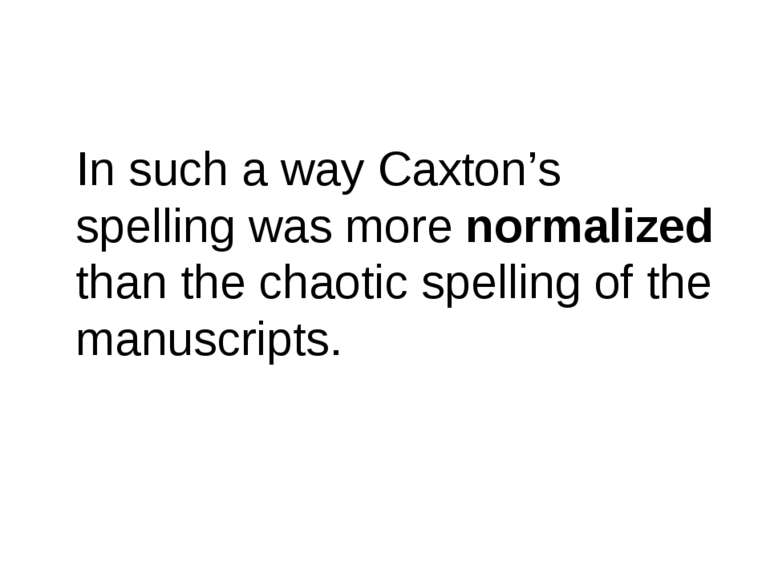

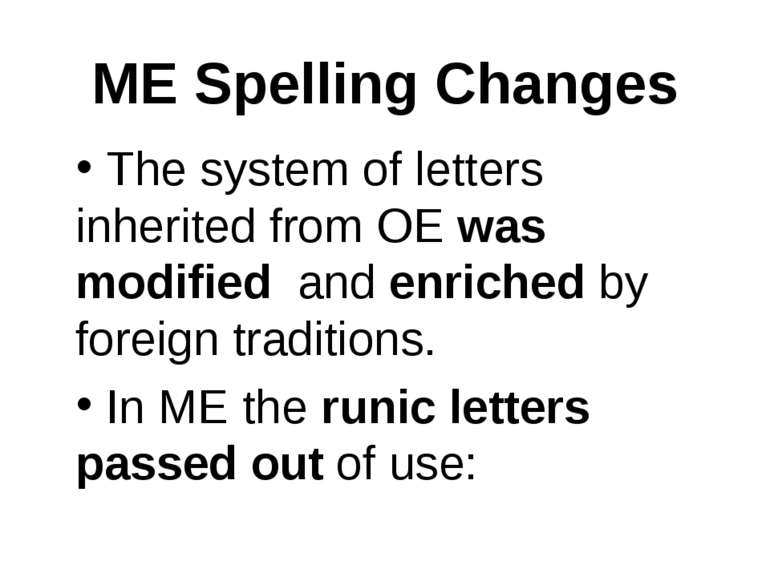

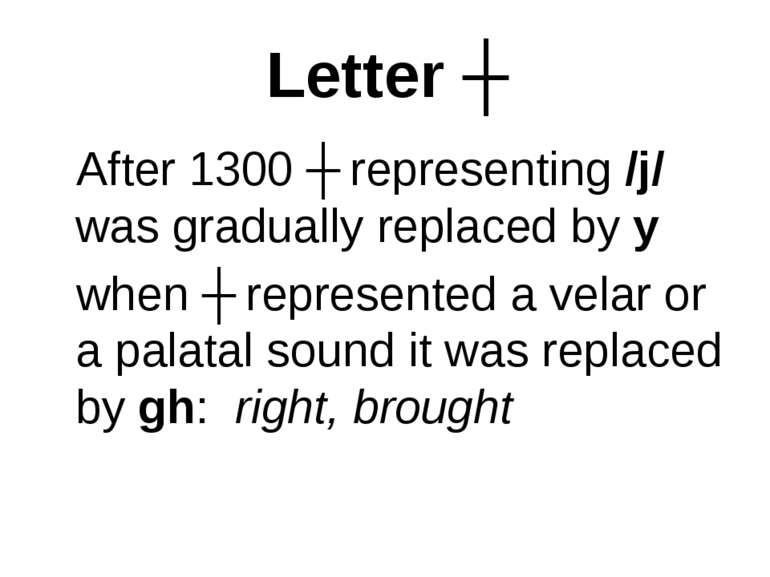


![E.g. ME double ['dVblq] out [Ht] chief [Ce:f] child [CJltd] much [mVC] E.g. ME double ['dVblq] out [Ht] chief [Ce:f] child [CJltd] much [mVC]](https://svitppt.com.ua/images/38/37753/770/img102.jpg)



![sh (ssh, sch) to indicate [S] ME ship – OE scip dg [G] ME edge [eGq] wh repla... sh (ssh, sch) to indicate [S] ME ship – OE scip dg [G] ME edge [eGq] wh repla...](https://svitppt.com.ua/images/38/37753/770/img106.jpg)

![Long [e:]could be indicated by ie and ee Long [e:]could be indicated by ie and ee](https://svitppt.com.ua/images/38/37753/770/img108.jpg)
![o was used not only for [o] but also to indicate short [V] alongside with the... o was used not only for [o] but also to indicate short [V] alongside with the...](https://svitppt.com.ua/images/38/37753/770/img109.jpg)

![w was interchangeable with u in the digraphs ou, au. e.g. ME doun, down [dHn]... w was interchangeable with u in the digraphs ou, au. e.g. ME doun, down [dHn]...](https://svitppt.com.ua/images/38/37753/770/img111.jpg)
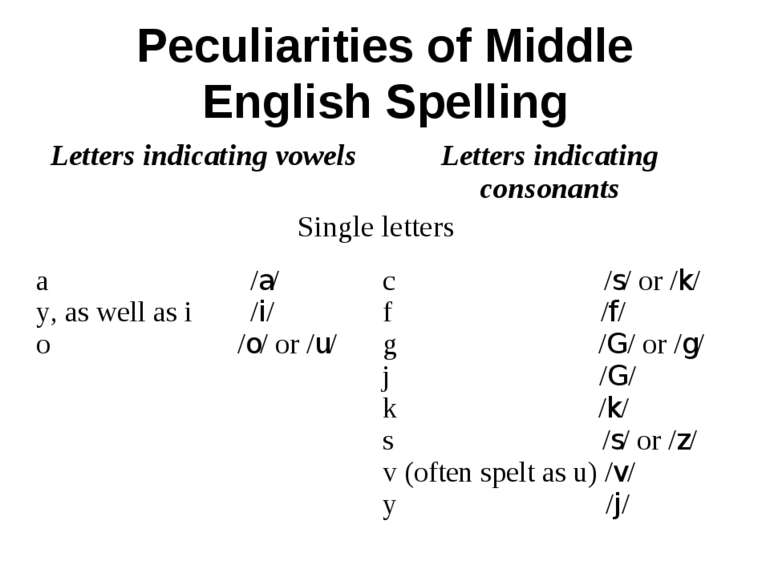



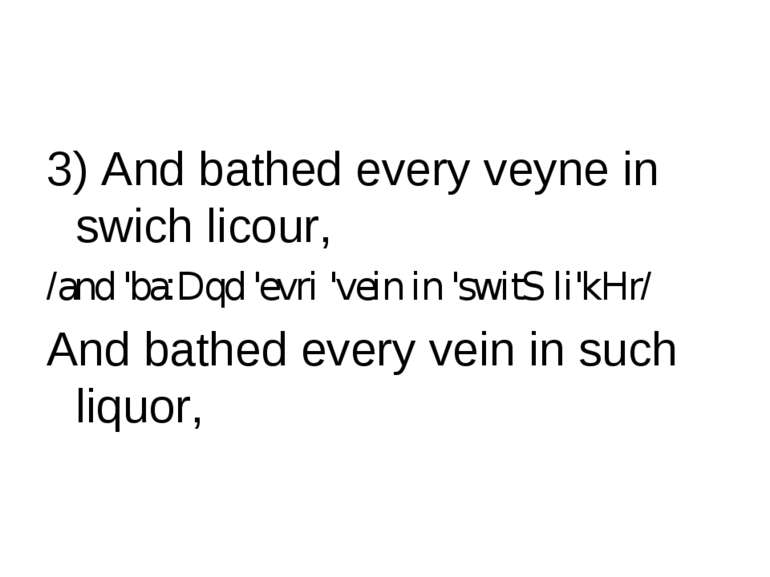
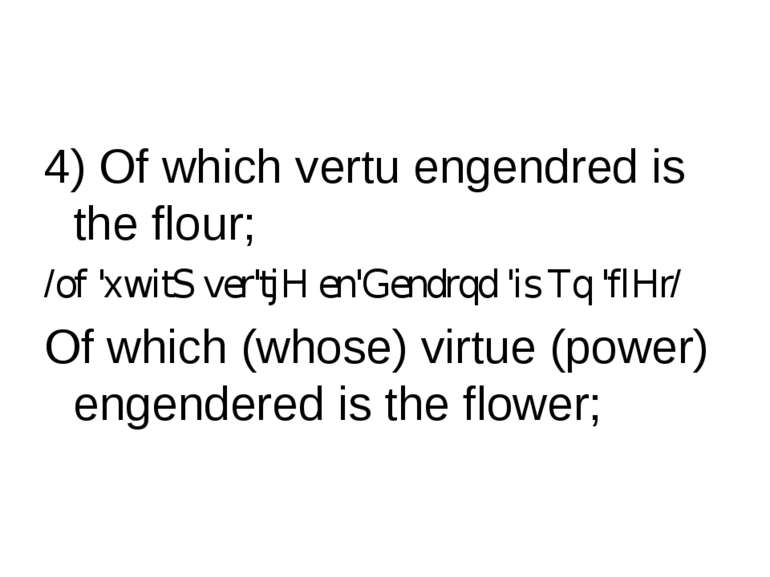






































































































![E.g. ME double ['dVblq] out [Ht] chief [Ce:f] child [CJltd] much [mVC] E.g. ME double ['dVblq] out [Ht] chief [Ce:f] child [CJltd] much [mVC]](https://svitppt.com.ua/images/38/37753/210/img102.jpg)



![sh (ssh, sch) to indicate [S] ME ship – OE scip dg [G] ME edge [eGq] wh repla... sh (ssh, sch) to indicate [S] ME ship – OE scip dg [G] ME edge [eGq] wh repla...](https://svitppt.com.ua/images/38/37753/210/img106.jpg)

![Long [e:]could be indicated by ie and ee Long [e:]could be indicated by ie and ee](https://svitppt.com.ua/images/38/37753/210/img108.jpg)
![o was used not only for [o] but also to indicate short [V] alongside with the... o was used not only for [o] but also to indicate short [V] alongside with the...](https://svitppt.com.ua/images/38/37753/210/img109.jpg)

![w was interchangeable with u in the digraphs ou, au. e.g. ME doun, down [dHn]... w was interchangeable with u in the digraphs ou, au. e.g. ME doun, down [dHn]...](https://svitppt.com.ua/images/38/37753/210/img111.jpg)

















